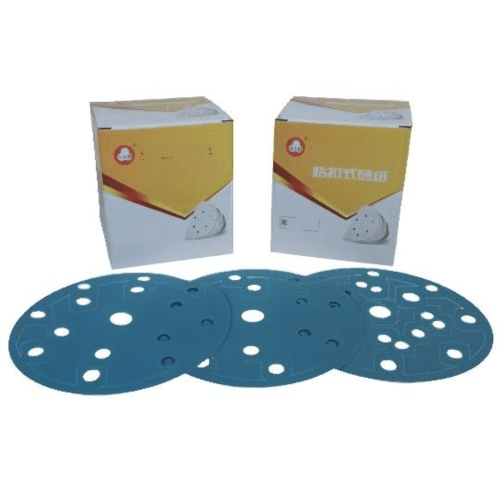Mastering Surface Preparation Through Effective Abrasion Methods
Surface preparation stands as the foundation of any successful finishing project, and sandpaper serves as the primary tool that craftsmen have relied on for generations. Whether you're refinishing furniture, preparing walls for paint, or smoothing wood for a perfect finish, understanding the proper use of sandpaper can make the difference between amateur results and professional-grade outcomes. The selection and application of appropriate abrasive materials directly impact the quality and durability of the final product.
Understanding Sandpaper Fundamentals
Grit Ratings and Their Applications
The effectiveness of sandpaper lies in its grit rating system, which indicates the size of the abrasive particles bonded to the backing material. Coarse grits, ranging from 40 to 80, are ideal for heavy material removal and initial surface preparation. Medium grits between 100 and 150 help in leveling surfaces and removing deeper scratches. Fine grits from 180 to 220 prove perfect for intermediate finishing, while ultra-fine grits above 320 deliver the smooth, refined finish needed for high-end projects.
Selecting the appropriate grit sequence ensures optimal surface preparation results. Professional woodworkers typically begin with a coarser grit and progressively work their way through finer grades, never skipping more than one grit level to avoid leaving visible scratches in the final finish.
Backing Materials and Their Importance
The backing material of sandpaper significantly influences its performance and application method. Paper-backed sandpaper offers flexibility and is excellent for hand sanding, while cloth-backed options provide durability for power sanding applications. Waterproof backing allows for wet sanding, which reduces dust and helps achieve ultra-smooth finishes, particularly on automotive surfaces or fine furniture.
Advanced Sanding Techniques
Manual Sanding Methodologies
Hand sanding requires proper technique to achieve optimal results. Always sand in the direction of the wood grain to prevent cross-grain scratches that might show through the finish. Using sanding blocks or pads helps distribute pressure evenly and prevents creating dips or valleys in the surface. For curved surfaces, flexible sanding sponges conform to contours while maintaining consistent pressure.
When hand sanding, maintain steady, even strokes with moderate pressure. Excessive pressure can create deep scratches and uneven surfaces, while too light pressure may not effectively remove material. Regular inspection of the work surface under good lighting helps identify areas needing additional attention.
Power Tool Applications
Power sanders dramatically increase efficiency in surface preparation, but proper technique remains crucial. Random orbital sanders help prevent swirl marks while providing aggressive material removal. When using power tools, keep the sander moving constantly to prevent dwelling too long in one spot, which can create depressions in the surface.
The selection of appropriate sandpaper for power tools requires consideration of both the material being sanded and the tool's specifications. Hook-and-loop backing systems offer quick changes between grits, while pressure-sensitive adhesive backings provide excellent durability for extended use.
Material-Specific Considerations
Woodworking Applications
Different wood species require varying approaches to surface preparation. Hardwoods typically benefit from starting with slightly finer grits compared to softwoods, as their dense grain structure can be more challenging to smooth effectively. Open-grained woods like oak may require grain filling between sanding stages to achieve a glass-smooth finish.
When working with veneers or thin wood surfaces, extra caution prevents sanding through the top layer. Using lighter pressure and higher grit numbers helps maintain surface integrity while achieving the desired smoothness.
Metal Surface Preparation
Metal surfaces present unique challenges in surface preparation. Aluminum requires specialized sandpaper to prevent clogging, while steel may need more aggressive grits to remove rust and scale. Wet sanding often proves beneficial for metal finishing, as it helps prevent heat buildup and provides superior surface quality.
Environmental and Safety Considerations
Dust Management Strategies
Effective dust collection systems protect both the worker and the environment during sanding operations. Using dust extraction equipment, whether connected to power tools or standalone systems, captures harmful particles before they become airborne. Regular cleaning of work areas and proper disposal of used sandpaper helps maintain a safe working environment.
Personal Protection Equipment
Proper safety equipment, including dust masks, eye protection, and hearing protection when using power tools, is essential for safe surface preparation. Long-term exposure to wood dust and other particles can cause respiratory issues, making proper protection crucial for both professional and DIY applications.
Frequently Asked Questions
How Long Does Sandpaper Typically Last Before Needing Replacement?
The lifespan of sandpaper varies significantly based on usage intensity, material being sanded, and grit size. Generally, sandpaper should be replaced when it stops cutting effectively or shows signs of loading (material buildup). For most woodworking applications, a sheet might last 15-20 minutes of continuous use before performance degradation becomes noticeable.
What Is the Best Way to Store Sandpaper?
Store sandpaper in a cool, dry place away from direct sunlight. Avoid folding or creasing sheets, as this can damage the abrasive surface. Storing sheets flat or rolled, depending on the backing material, helps maintain their effectiveness. Consider using dedicated storage solutions that protect against moisture and contamination.
Can Different Types of Sandpaper Be Used for Wet Sanding?
Only sandpaper specifically designed for wet sanding should be used with water or lubricants. These products typically have waterproof backing and special adhesives that maintain integrity when wet. Standard paper-backed sandpaper will disintegrate when exposed to moisture, making it unsuitable for wet sanding applications.


